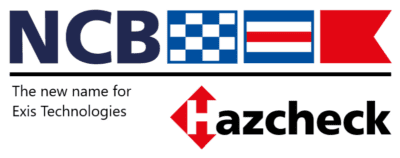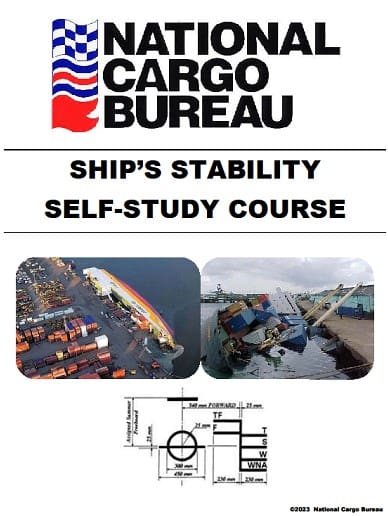Product Overview
The course is a practical introduction to the subject of ship’s stability in the form of a U.S. Coast Guard-approved correspondence course consisting of 14 modules. The fee for the course covers the cost of all materials necessary to complete the training.
This course was originally designed to ensure that National Cargo Bureau (NCB) surveyors understood and were able to properly apply the stability concepts necessary for safe loading and carriage of bulk grain, and to utilize this knowledge in other areas of their profession where concern for ship’s stability is required.
It has since been made available, as a self-study course, to all who may have a need or an interest in this subject. This includes vessels’ officers, operators, charterers, stevedores, agents and anyone else that may have a direct influence on, or concern for the outcome of, the loading of vessels with bulk grain.
This course addresses both statical stability, dealing with initial stability as measured by GM, and dynamical stability, which is concerned with the righting energy of the vessel over a range of angles of heel. The International Code for the Safe Carriage of Grain in Bulk (International Grain Code) is largely based upon dynamical stability and the latter part of this course deals with the stability calculations necessary to demonstrate compliance with the International Grain Code as well as United States Coast Guard (USCG) alternatives.
Basic stability concepts that have common and regular practical use onboard are also included, such as draft survey, trimming calculation, determining list, dock water allowance calculations, and deepest draft due to list or trim.
The material in the course booklet constitutes the text. In addition, a copy of NCB’s publication, “General Information for Grain Loading” is provided with the course, along with an excerpt copy of a Grain Stability Booklet for a Panamax bulk carrier. Use of other stability textbooks as additional guidance is useful but not required.
The course is approved by the U.S. Coast Guard and upon successful completion (70% or better), in addition to the certificate of training, the U.S. mariner participant may be eligible for 14 days sea-service credit towards a license or raise in grade.
How to buy
Continental United States – Select the option to the right of this page and add to basket. Please note Course materials will be sent direct to the information provided in the Billing address (Continental United States only).
For other destinations please contact us here, as charges will vary for shipping of course materials.
-
COURSE CONTENT
Module 1 – Introduction to Stability
- Archimedes Principle
- Vessel Motions
- Transverse Stability
- Stability Regulations
- Intact Stability Code
- Stability Instruments
Module 2 – Introduction to Transverse Stability
- GM, Equilibrium, Righting Moment, Initial Stability
- Angle of Loll
- Stability Curves, GZ Curve
- General Intact Stability Criteria
Module 3 – KM and KG, Vertical Position of G, Ship’s Rolling and Initial Stability
- KM and KG
- Vertical Moments, Shift of G
- Good GM, Rolling Period
- Synchronized Rolling, Anti-roll Devices
Module 4 – Calculating Areas, Simpson’s Rules, Transverse Metacenter, Finding KM from KB and BM
- Trapezoidal Rule, Simpson’s Rules
- Waterplane and Ship Hull Volume Calculations
- KB and BM, Morrish Formula
- Metacentric Diagrams
Module 5 – Transverse Shift of G; Inclining Test
- Calculating Heel and List
- Increase in Draft Due to List
- Lightship Condition
- Inclining Test Procedure
- Inclining Test Formula and Its Uses
Module 6 – Longitudinal Shift of G; Trim
- True Trim
- Calculating LCG and LCF
- Change of Trim
- Calculating Desired Draft and Trim
Module 7 – The Effects of Density and Free Surface
- TPC
- Calculating FWA and DWA
- Deflection
- Draft Means and Draft Survey Basics
- Free Surface
Module 8 – Large Angle Stability
- Cross Curves of Stability
- Statical Stability Curve, Moment of Statical Stability
- Dynamic Stability, Practical Use of GZ Curve
- Deck Edge Immersion, Wall-sided Formula
Module 9 – Longitudinal Hull Strength
- Ship Building Materials
- Stresses, Basic Beam Theory
- Shear Stress, Bending Moment
- Bonjean Curve, Wave Action, Torsional Stress
- Loading Manuals and Instruments
Module 10 – The International Grain Code (Concepts and Assumptions)
- Grain Regulations
- Leveling and Trimming
- Volumetric and Grain Heeling Moments
- Vertical Shift of G
- Grain Loading Booklet
Module 11 – Stability Requirements for Vessels Loading Bulk Grain – Criteria and Compliance
- Angle of Flooding
- Grain Statical Stability Diagram
- Maximum Allowable Heeling Moment
- Methods of Reducing Grain Heeling Moment
Module 12 – Stability Requirements for Vessels Loading Bulk Grain – Code Requirements and U.S. Alternatives
- Specially Suitable Compartment
- Filled Compartment – Trimmed / Untrimmed
- Document of Authorization
- US Grain Regulations
- USCG NVIC 5-94, Exemptions
Module 13 – Stability Requirements for Vessels Loading Bulk Grain – Grain Stability Calculations
- NCB Grain Stability Calculation Form
- Addendum 1, Addendum 2
Module 14 – Load Lines; Voyage Planning
- Load Line Convention
- Maximum Cargo Intake
- Create a Grain Voyage Plan
-
COURSE FORMAT
This is a correspondence course, wherein the student is guided by a proctor primarily via email exchanges. Also known as a self-study distance learning format, the student can conveniently go at his own pace through the course. A three month completion window is recommended, but not required. One year is considered by most as an upper limit target.
In order to pass the course, students must achieve a minimum of 50% for each module and a rounded overall average of at least 70%. Certificates will be awarded to successful students.
As each lesson build upon the previous, tests are submitted one at a time as modules are completed. Students can then be assured that any concerns are addressed before they impact future module tests. NCB offers support to students through the course proctor at no additional charge.









